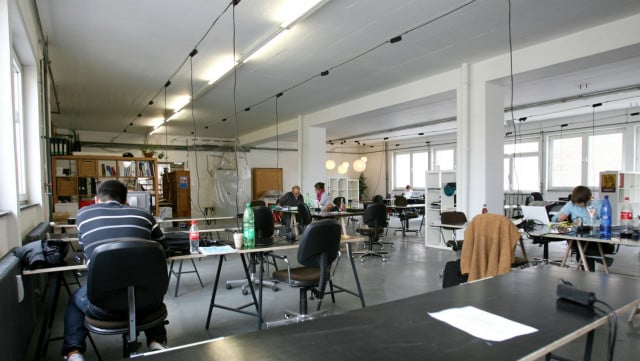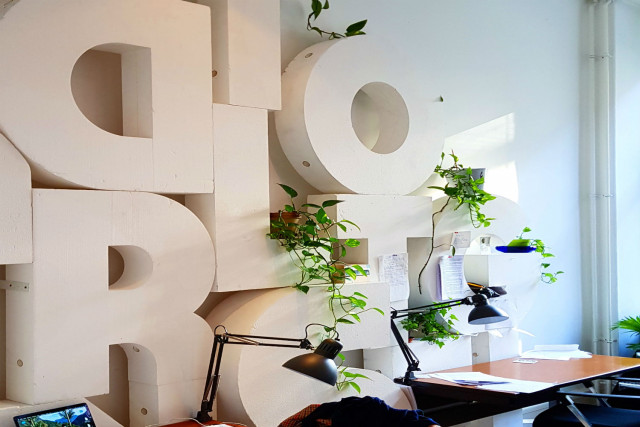Co-working has been making waves for a while now, and nowhere more so in Germany than Berlin. The city has nearly 200 co-working spaces, from standard offices to unconventional locations like attics and renovated industrial units.
In the wake of recent difficulties at US giant WeWork, however, questions are being asked about the industry’s long-term viability.
WeWork currently has more than 800 spaces worldwide but the company’s recent plans to file for an IPO fell through spectacularly, leading to the departure of CEO Adam Neumann and the threat of swingeing job cuts. Japanese investors Softbank have just agreed to extend funding to the tune of $5 billion.
So is co-working still working – for whom and for how much longer?

Co-workers at Betahaus in Berlin. Photo: DPA
The Berlin Scene
Berlin is Germany’s undisputed capital of co-working, with the largest and most diverse range of co-working spaces.
“The scene has grown unbelievably fast,” says Björn Budack, CEO of Kiez Büro which offers co-working spaces in Berlin and Hamburg. He estimates half of Germany’s roughly 350 co-working spaces are in the capital and links growth to the city’s bullish property market.
“Renting offices in Mitte has become almost impossible,” he says. Commercial leases are expensive and high occupancy rates mean there is simply not enough room available.
Between 2013 and 2018, office vacancy rates across the city decreased from 5.4 percent to 1.7 percent, and in the first quarter of 2019 shrunk to 1.5 percent. In Mitte, there is even more of a squeeze – according to Björn, as little as 0.3% of office space is available.
Combined with Berlin’s dynamic tech start-up scene, which often employs freelancers or teams working remotely, it makes sense for many in the city to rent short-term, flexible office space.
These typically offer added benefits like kitchens, free coffee and fruit, 24-hour opening hours, and comfortable surroundings in which to network with like-minded people.
Is it affordable?
WeWork has seven spaces in Berlin, including prestigious addresses on the Ku’damm, atop the Atrium Tower and in the Sony Centre at Potsdamer Platz, plus two newly announced locations at Neue Bahnhofstrasse and at Warschauer Strasse in Friedrichshain.
Known for charging premium prices, different memberships are available and depend on location: basic access is around €200-300 per month, with the cost of a fixed desk rising to €450-550.
Private offices are also available: for a team of eight, for example, monthly fees range from €4000 up to €7000 per month. Other brands in the city are more affordable.
READ ALSO: What are Berlin's most affordable co-working spaces?
Betahaus is one of Berlin’s first and most popular coworking names, with premises in Neukölln and Kreuzberg. ‘Club’ membership costs €99 per month and for €250, ‘Pro’ membership gives extra perks and access to better equipped areas.
Others like Factory Berlin offer flexible membership for as little as €50 a month, with further reductions available for students.
Co-workers
Julie Gossart is a music booking agent at Sabobe and rates her membership with co-working space Betahaus, one of Berlin’s first and most popular with premises in Neukölln and Kreuzberg, as “the best professional decision I’ve made this year”.
Previously, she found working from home to be a daily struggle, while Berlin’s many cafés offered a more productive but expensive alternative.
“In cafés sometimes I spent €15 a day. It was not so good for my wallet,” Gossart told The Local.
Co-working provides structure and daily motivation, she says. “It gets me up in the morning, a bit like the gym.”
Gossart aims to arrive at the office in Neukölln by 9 to bag her favourite spot.
“Some people move around the whole time but I like to always work from the spot which suits me best,” she said.
For Gossart, “the idea is to feel free” and having the choice of where and when to work is important. “I never much liked the idea of co-working but now I recommend it to friends. Only an idiot doesn’t change their mind sometimes.”
Joseph Finlayson, CTO at banking app Sable, is also positive about his experiences of co-working.
He appreciates the chance to interact with other people, though the space he uses on Rudi-Dutschke Straße can get busy on peak days, making good desks harder to find.
“I’ve never seen it at full capacity though. It’s more usually at about 50 percent.”
He has been using the co-working space as a stopgap while he finalizes the lease on an office for his team of five. Like Gossart, his co-working membership is paid for by his company.
“I’d say that’s true of most people here. For business with no office and a small team, it makes sense. It’s so convenient.”
He is sceptical, however, about the cost-effectiveness for freelancers and turned down an offer to make the co-working space a long-term base. “It works for some mid-size companies but not for us.”
Business or culture?
For some, co-working is a straightforward (and very profitable) business model, while for others it represents a cultural turn toward new styles of working, in which freedom and collaboration are key.
Major international players like WeWork, IWG (previously Regus) or Knotel are in essence property companies which turn a profit largely through rental arbitrage, explains Julian Jost, CEO of meeting room booking platform Spacebase.
“Their model for making office space rentable can be very lucrative. They sign leases on office space in desirable locations, from New York to Berlin to Tokyo. These buildings get renovated, adding state-of-the-art facilities, futuristic meeting rooms and sleek interior design, at the same time maximising capacity per square metre.”
These large spaces make renting terms more flexible and absorb the risk for small companies. “To rent an office in Berlin, say I need to sign a 5-year lease,” Jost says.
“Firstly, this is a huge investment – not only do I pay the lease for five years, I also put down the deposit and pay to equip the space for my team. Then, I need to be sure it will be worth the money in the long-term. You need an office which is bigger than your current team if you plan to grow over those five years, but too big and it isn’t cost-effective.”
Co-working simplifies all this. “Bottom line, it makes starting a company less risky. The co-working business takes on the risk, which you pay for in your membership fee.”
This form of luxury office-as-service is in contrast to independent local outfits, which typically are part of what Björn Budack calls “the co-working movement, where it’s about a culture rather than a product”.
On this end of the spectrum, devotees are more interested in new ways to collaborate as members of a community, according to shared values – away from the competitiveness of the corporate world or the pull of global brands.
John Neilan, founder of Schöneberg-based tuesday coworking, resists such an ‘either/or’ distinction and brings it back to individual preference – it’s about people feeling comfortable, wherever they work. While freelancers at tech start-ups might spring to mind, “plumbers need to do their taxes at some stage too”.

Photo courtesy of Sam Bender of Cobot.
He sees co-working as a reflection of wider working trends and observes “a lot of company offices moving away from cubicles, tables and chairs to high tables, stools, couches and an altogether more casual approach to workspace design.”
Jost agrees. “Especially among a new generation of millennials integrating into the workforce, there is demand for work and meeting spaces that are comfortable and flexible.”
For him, giving people the autonomy to choose working hours and locations allows them to break out of old habits and develop new approaches to their tasks. “Most of us aren’t productive or creative when we feel stuck behind a desk.”
The future
So will we all become free and flexible co-workers one day?
Probably not. Björn Budack estimates only 15 percent of Berlin’s roughly 2.3 million square metres of office space is used for co-working – it is a growing segment but still one limited in scope, mostly to “an urban tech start-up elite”.
As he points out, most people do not work in offices, and for those who do, the 9-5 structure of jobs hasn’t changed substantially in the last 50 years.
For John, the future is difficult to foresee. “You could look at what happened to Internet cafés. They died a death fairly swiftly.”
He is focused on diversifying what tuesday coworking offers and collaborating with other spaces to keep the community relevant. “I only recently heard the expression: “If you want to go fast, go alone. If you want to go far, go together”



 Please whitelist us to continue reading.
Please whitelist us to continue reading.
Member comments